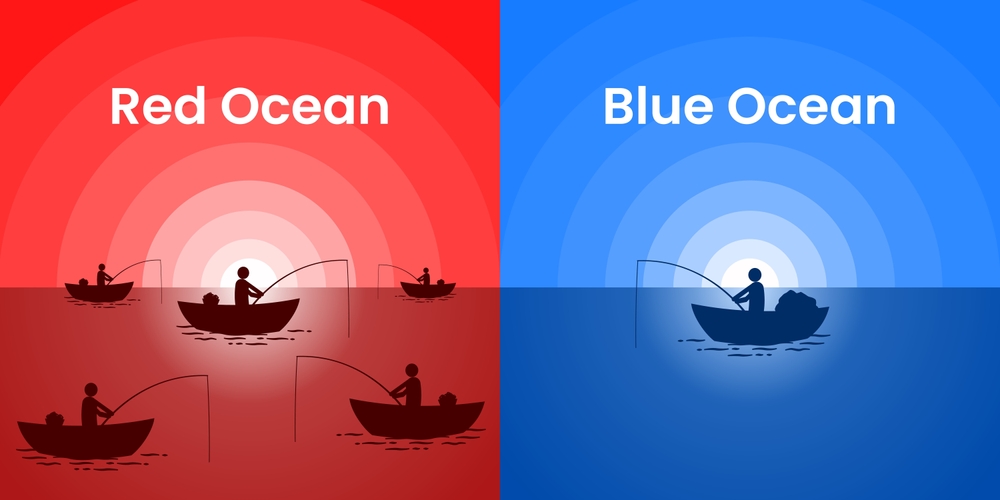
Introduction
In this dynamic world of marketing, the concept of “Oceans” has become an important framework. This framework helps in understanding competitive strategies. It is based on two distinct types of markets: the Red ocean and the Blue ocean. These concepts provide valuable insights for businesses. Companies can use this knowledge to gain a competitive edge and create sustainable growth.
Understanding the Red Ocean
The “Red ocean” represents the traditional, existing markets that are filled with competitors. In these crowded spaces, companies engage in intense competition, vying for a larger share of the available customer base. Businesses in the Red ocean often resort to lowering prices or offering better deals to attract customers, leading to a cutthroat battle for survival.
Examples of Red oceans include:
Coca-Cola vs. Pepsi: The soft drinks market is a prime example of a Red ocean, where Coca-Cola and Pepsi engage in fierce marketing campaigns and price wars to maintain their market share.
McDonald’s vs. Other Fast-Food Chains: The fast-food industry is another Red ocean, where McDonald’s and its competitors focus on competitive pricing, menu offerings, and customer experience to attract and retain customers.
Exploring the Blue Ocean
In contrast, the “Blue ocean” refers to new, creative, untapped market spaces where there is little to no competition. In these uncontested markets, companies can innovate and create unique products or services. They can build a new market space that emphasizes delivering exceptional value to customers. This approach allows them to avoid direct competition.
Examples of Blue oceans include:
Netflix: The online streaming giant disrupted the traditional entertainment industry by offering a convenient and innovative way to watch movies and TV shows, creating a Blue ocean that was previously untapped.
Tesla: The electric vehicle manufacturer has carved out a distinct position in the automotive market by focusing on advanced technology, sustainability, and a premium driving experience, effectively creating a Blue ocean.

What Is The Purple Ocean?
More recently, the concept of the “Purple Ocean” has gained attention. The Purple ocean represents a hybrid market, where a strategy blends elements of both Red oceans and Blue oceans. In a Purple ocean, companies aim to create a distinctive market position by offering creative solutions with a competitive edge, leveraging both innovation and competition.
One example of a Purple ocean is the smartphone market, where companies like Apple, Samsung, and Google compete fiercely while also introducing innovative features and technologies to differentiate their products from those found in Red oceans.
Navigating the Oceans: Strategies for Success In 2025
Regardless of the type of ocean a business operates in, the key to success lies in understanding the dynamics of the market and developing a strategic approach that aligns with the prevailing conditions.
In a Red ocean, companies may need to focus on cost-cutting, operational efficiency, and differentiation to stand out from the competition. Strategies such as market segmentation, targeted marketing, and customer-centric innovation can help businesses thrive in these crowded spaces.
On the other hand, in a Blue ocean, the focus should be on creating new demand, identifying unmet customer needs, and developing unique value propositions. Businesses in Blue oceans often prioritize innovation, disruption, and strategic positioning to establish a dominant market presence.
In a Purple ocean, a hybrid approach is required, where companies balance the need for innovation and creativity with the realities of competition found in Red oceans. This may involve a combination of cost leadership, differentiation, and niche targeting to carve out a distinctive market position.
Conclusion
The concept of “Oceans” in marketing provides a valuable framework for understanding and navigating the competitive landscape. By recognizing the characteristics of Red oceans, Blue oceans, and Purple oceans, businesses can develop informed strategies to gain a competitive edge, create new market spaces, and achieve sustainable growth.
At Udjat Agency, we have a deep understanding of these marketing concepts. We can help our clients navigate the complexities of the modern business environment. AtUdjat Agency, we understand these marketing concepts well. We help our clients navigate the complexities of the modern business environment. Our team uses data-driven insights, creative solutions, and strategic planning. This support helps our clients thrive in their respective oceans, whether they are in Red oceans or exploring Blue oceans.
By embracing the “Oceans” framework, businesses can find new opportunities. They can also stay ahead of the competition in Red oceans and deliver great value to their customers in Blue oceans.
Discover The RACE Framework Benefits Before 2025 Through Udjat Agency



